ICSE Class 10 Biology The Endocrine System Questions and Answers
ICSE SolutionsSelina ICSE Solutions
APlustopper.com provides ICSE Solutions for Class 10 Biology Chapter 9 The Endocrine System for ICSE Board Examinations. We provide step by step Solutions for ICSE Biology Class 10 Solutions Pdf. You can download the Class 10 Biology ICSE Textbook Solutions with Free PDF download option.
Download Formulae Handbook For ICSE Class 9 and 10
Short Questions
Question 1: What do you mean by endocrine system ?
Answer: In human body there are two types of glands—exocrine and endocrine. The exocrine glands have ducts and discharge their secretions through them, e.g., salivary glands, liver, etc. The endocrine glands are those which do not possess any duct and discharge their secretion (hormones) directly into the blood stream to send them to the various parts of the body. The endocrine glands and their secretion (hormones) constitute the endocrine system which along with nervous system coordinates the activity of various parts of the body.
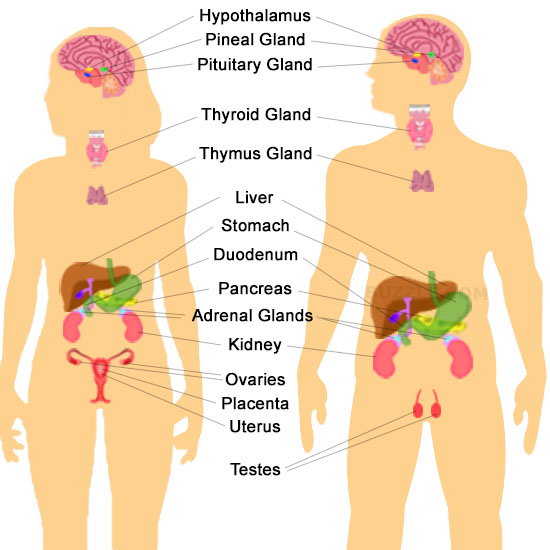

Question 2: What is a hormone ?
Answer: A hormone is defined as a chemical substance produced by the endocrine glands situated in one part of the body and carried by the blood to some other parts of the body in order to exert its regulating and co-ordination effect on the cells of a specific organ or tissue.
Question 3: What are endocrine glands ?
Answer: The endocrine glands are ductless glands which secrete hormones. They are poured directly into the blood stream and carried to different parts of the body. Hormones act as chemical messengers and coordinate the activities of various body organs. Chemically, hormones are proteins, amino acids or steroids.
Question 4: What is the chemical nature of hormone ?
Answer: Chemically hormones are not always protein, but they are of different chemical natures. They may be protein as insulin, polypeptide like parathyroid hormone or epinephrine.
Question 5: Why are hormones called ‘chemical messengers’ ?
Answer: The hormones are carried to all the parts of the body through blood circulation to bring about the harmonious working of the body. So, they are called chemical messengers.
Question 6: What are the general properties of hormones ?
Answer: General properties of hormones:
(i) Hormones are secreted by the endocrine glands.
(ii) Hormones are specific in function.
(iii) Hormonal actions are long lasting.
(iv) Hormones are required in very minute quantities.
(v) They are secreted independent of one another.
(vi) They act as chemical co-ordinators or chemical messengers.
(vii) They are proteinaceous or steroid in nature..
(viii) They are secreted in response to specific stimuli.
Question 7: Which parts of the alimentary canal produce hormones ?
Answer: The parts of the alimentary canal which produce hormones are the stomach and intestine. The stomach produces a hormone Gastrin. It stimulates the gastric glands to secrete gastric juices.
Question 8: Name the different endocrine glands found in the body of man.
Answer: 1. Pituitary gland
2. Thyroid gland
3. Parathyroid gland
4. Adrenal gland
5. Gonads (Testes, ovary)
6. Thymus gland
Question 9: What are tropic hormones ?
Answer: The hormones secreted from anterior pituitary, that stimulate certain other endocrine glands, are called trophic hormones.
Question 10: Name the hormone produced by the following glands giving one function of each.
(i) Thyroid.
(ii) Pancreas
(iii) Adrenal medulla
Answer: (i) The thyroid secretes thyroxin. It controls basal metabolic rate (BMR), growth and differentiation of the body.
(ii) Pancreas secretes insulin and glucagon. These hormones control blood glucose level. Insulin decreases while glucagon increases blood glucose level.
(iii) Adrenal medulla secretes adrenaline. It controls heart beat and blood pressure and helps in providing glucose to the body in order to overcome emergency situations. It is also called the emergency hormone.
Question 11: Write about some functions of adrenal glands.
Answer: Functions of adrenal glands:
(i) Prepare the body for emergencies.
(ii) Regulate the kidney in maintaining salt and water balance.
(iii) Control blood pressure and pulse rate.
(iv) Control concentration of sodium, potassium and sugar in the body.
(v) Control some sexual characteristics.
(vi) Influence the breakdown of tissue proteins into amino acids.
Question 12: Are the following glands exocrine or endocrine glands ?
(i) Salivary gland, (ii) Liver, (iii) Thyroid gland, (iv) Pancreas, (v) Adrenal.
Answer: (i) Salivary glands: Exocrine gland.
(ii) Liver: Exocrine gland.
(iii) Thyroid gland: Endocrine gland.
(iv) Pancreas: Has acini cells which act as exocrine glands and the Islets of langerhans act as endocrine glands.
(v) Adrenal: Endocrine gland.
Question 13: Which hormones are secreted by anterior pituitary gland ?
Answer: 1. Growth hormone.
2. Thyroid stimulating hormone.
3. Follicle stimulating hormone.
4. Luteinizing hormone.
5. Adrenocorticotrophic hormone.
Question 14: How is iodine important to our body ?
Answer: Iodine is the active ingredient in the production of thyroxin hormone. If there is insufficient quantity of iodine in food, the thyroxin hormone is not produced. As a result, thyroid gland increases in size which is Visible as a swelling in the neck. This condition is known as goitre.
Question 15: Where is the thymus gland located and what is its function ?
Answer: The thymus gland is located in the’mediastinum in front of the heart. This secretes a hormone thymosin which stimulates the lymphocytes to destroy invading microorganisms and antigens. It degenerates on aging, decreasing the immunity in old age.
Question 16: People living in hilly regions usually suffer from simple goitre. Explain.
Answer: Iodine is essential for the production of thyroxin by the thyroid gland. The people living in hilly regions receive insufficient iodine in their diet, due to the fact that they drink iodine deficient water from rivers and streams fed by melting snow. Even their diet has little or no iodine. When there is a deficiency of iodine in the diet the thyroid gland enlarges in order to compensate for this deficiency resulting in goitre.
Question 17: What is osteoporosis and what is its cause ?
Answer: Osteoporosis is a disease caused due to excessive secretion of parathormone. In this, the bones become weak, elastic and bent.
Question 18: Write in brief about the causes and symptoms of exophthalmic goiter.
Answer: Exophthalmic goitre or Grave’s disease is caused by overactivity of the thyroid gland. The thyroid increases in size and leads to an increased metabolic rate, a high rate of heart beat and wasting away of the tissues of the body.
The apparent symptoms are:
(a) Goitre (Swelling in the neck). (b) Protuberance of the eyeballs.
(c) The patient feels tired, nervous and restless.
Question 19: List some of the functions of pituitary gland.
Answer: Functions of pituitary gland:
(i) Regulates growth.
(ii) Influences the thyroid gland, the adrenals and gonads.
(iii) Can produce changes in the skin colour of many amphibians.
(iv) Influence migration and nest buildings in birds.
(v) Controls and stimulates the secretion of other endocrine glands.
Question 20: What are the two kinds of diabetes ? Mention their symptoms and the causes.
Answer: Two kinds of diabetes are:
(i) Diabetes insipidus (ii) Diabetes mellitus.
Symptoms and causes of diabetes insipidus:
(i) It is due to deficiency of antidiuretic hormone (ADH).
(ii) In this urination is frequent and copious, resulting in loss of water from the body and the person feels thirsty.
Symptoms and causes of diabetes mellitus:
(i) It is due to insufficient secretion of insulin hormone.
(ii) Presence of glucose in urine and high level of glucose in blood.
Question 21: Complete the following :

Answer:
| Gland/Organ | Hormone | Function |
| (i) Stomach | Gastrin | Stimulates secretion of gastric juices. |
| (ii) Parathyroid | Parathormone | Regulates calcium metabolism. |
| (iii) Pancreas (Beta cells) | Insulin | Lowers blood sugar level. |
| (iv) Adrenal medulla | Adrenaline | Helps body to adapt stress and other extreme conditions. |
| (v) Pancreas (Alpha cells) | Glucagon | Raise blood sugar level. |
| (vi) Testes | Testosterone | Development of primary and secondary sex characters in males. |
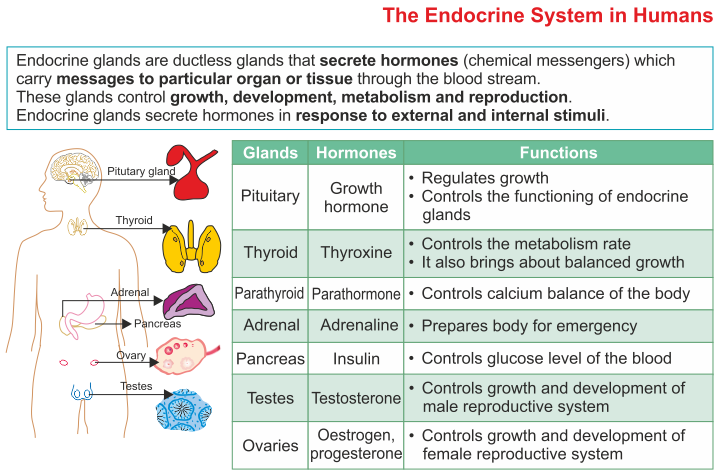
Question 22: Given below is a table consisting of a set of items belonging to a common category. Complete the table by filling in the category and the odd one in the blanks.
| Set | Category | Odd one |
| Adrenaline, Penicillin, Insulin, Thyroxin | ||
| Vasopressin, growth hormone, TSH, ACTH, FSH |
Answer:
| Set | Category | Odd one |
| Adrenaline, Penicillin, Insulin, Thyroxin | Hormones | Penicillin |
| Vasopressin, growth hormone, TSH, ACTH, FSH | Hormones from anterior Pituitary | Vasopressin |
Question 23: Complete the table given below by filling in the blanks numbered 1 to 8.
| Gland | Hormone Secreted | Effect on Body |
| 1 | 2 | Regulates basal metabolism |
| Pancreas ((3-cells) | 3 | 4 |
| 5 | 6 | Increases heart beat |
| 7 | Thyroid stimulating hormone | 8 |
Answer:
1. Thyroid
2. Thyroxin
3. Insulin
4. Controls blood sugar level
5. Adrenal
6. Adrenaline
7. Pituitary
8. Stimulates thyroid gland
Give Reasons
Question 1: Hormones are called ‘chemical messengers’.
Answer: The hormones are carried to all the parts of the body through blood circulation to bring about the harmonious working of the body. So, they are called chemical messengers.
Question 2: Organs like the stomach and intestine are also endocrine glands. Why ?
Answer: The mucous lining of the stomach and intestine produce certain hormones which regulate the secretion and flow of certain digestive juices. So these are endocrine glands.
Question 3: The thyroid gland is called as nature gland.
Answer: The thyroid gland is also called as nature gland because it secretes thyroxin hormone which is mainly responsible for the normal behaviour of human beings. In adequate supply of hormones human behaviour remains normal. In case of excess supply of hormones in the blood there are increased metabolic activities, raised nervous excitability and increased physical activity accompanied by fatigue and loss of weight.
Question 4: Goiter is usually observed in people living in hilly regions.
Answer: The soil and water in hilly regions is deficient in iodine. Hence goitre is usually observed in people living in hilly regions.
Question 5: The thymus is larger and more prominent in children than is adults.
Answer: The thymus gland is supposed to stimulate growth and provide immunity in children. Hence it is larger and more prominent in children than in adults.
Question 6: Pancreas is both an exocrine gland and an endocrine gland. Explain.
Answer: Pancreas is a heterocrine or myxocrine gland, as it contains two types of secretary structures, i.e., (i) Islet of Langerhans which secrete hormones insulin and glucagon, and these are transported by way of blood, and (ii) Acini that secretes pancreatic juice that is transported by way of ducts.
Question 7: Insulin is injected into the body of a highly diabetic patient and not given orally. Explain.
Answer: Insulin is a protein hormone and if it is given orally it would be acted upon by the protein digesting enzymes in the alimentary tract. So it is injected into the body of highly diabetic patient and is able to travel in the blood stream to bring about the required specific effect.
Question 8: The pituitary is called the master gland.
Answer: The hormones of pituitary gland regulate so many activities of the body and other endocrine gland Hence, it is called master gland.
Question 9: Adrenaline is also known as emergency hormone.
Answer: Adrenalin is secreted at the time of emergency (stress or strain) and prepares the body to fight, fright and flight. So, it is also known as emergency hormone.
Question 10: Our hair stands on their ends during fear.
Answer: During fear adrenal medulla secretes adrenaline which prepares the body to face fear by increasing heart beat, blood pressure and energy production. That is why our hair stands on their during fear.
Question 11: Some adult women may develop facial hairs. What may be the cause for it ?
Answer: If there is an overgrowth of the adrenal cortex in an adult woman, she develops facial hairs. This condition is known as adrenal virilism.
Question 12: The release of progesterone in the urine is an indication of pregnancy. Explain.
Answer: Because progesterone brings about changes in the uterus for the retention and growth of pregnancy.
Differentiate
Question 1: Endocrine gland and Exocrine gland.
Answer:
| Endocrine gland | Exocrine gland |
| (i) These are ductless glands. | They may or may not have ducts. |
| (ii) They pour secretion directly into the blood. | The secretion is poured directly at the sight of action or reaches the target. |
| (iii) They secrete hormones. | They secrete enzymes. |
| (iv) They control long term activities of target organs, e.g., thyroid glands. | They control short term activity, e.g., gastric gland. |
Question 2: Hormones and Enzyme.
Answer:
| Hormones | Enzyme |
| Act at sites usually far away from source. | Act usually within the same cell or at the most close to the cell. |
| Always transported by blood. | Not transported by blood. In some cases transported by ducts. |
| Chemically may be proteins, steroids or amino acids. | Chemically always protein. |
Question 3: Insulin and Glucagon.
Answer:
| Insulin | Glucagon |
| It is secreted by P-cells of Islets of Langerhans. | It is secreted by a-cells of Islets of Langerhans. |
| It converts the excess glucose into glycogen. | It converts the glycogen into glucose. |
Question 4: Nervous control and Hormonal control.
Answer:
| Nervous Control | Hormonal Control |
| The information is sent in the form of electric signals. | The information is sent in the form of chemical signals. |
| The signals travel through nerve fibres to specific target cells like muscle fibres and glands. | The signals travel through blood stream to cells in different organs. |
| Nervous system causes muscles to contract or relax, glands to secrete more or less. But it cannot bring about growth. | Endocrine system brings about changes in metabolic activities of all body tissues. It affects growth. |
| Action is immediate (within few milliseconds.) | Action is slow (can take hours or days to produce response). |
| Effect lasts for a sliort time. | Effect is more lasting and permanent. |
Question 5: Cretinism and Myxedema.
Answer:
| Cretinism | Myxedema |
| Caused by hyposecretion of thyroxine in infants. | Caused by hyposecretion of thyroxine in adults. |
| It is characterized by stunted growth, pot belly, protruding tongue and pigeon chest. | It is characterized by puffy appearance due to accumulation of fat in the subcutaneous tissue and oedema (accumulation of water in tissue space). |
| Mental and sexual retardation takes place. | Mental and sexual development is not affected but patients lack alertness. |
Question 6: Gigantism and Acromegaly.
Answer:
| Gigantism | Acromegaly |
| Caused by over-secretion of somatotropin in childhood. | Caused by over-secretion of somatotropin after adolescence. |
| Due to abnormal elongation of bones and muscles, person is of abnormally large height. | Abnormal increase of bones of hands and legs, and the lower jaw, person has gorilla like appearance but is not a giant. |
Question 7: Simple Goitre and Exophthalmic Goitre.
Answer:
| Simple Goitre | Exophthalmic Goitre |
| It is caused by the deficiency of iodine. | It is caused by the over activity of thyroid gland. |
| It can be-covered by adding iodine in the diet. | It can be cured by killing the thyroid cells or removing of portion of the thyroid gland. |
Question 8: Diabetes mellitus and Diabetes insipidus.
Answer:
| Diabetes mellitus | Diabetes insipidus |
| It is caused by the deficiency of insulin. | It is caused by the deficiency of ADH. |
| Patient’s urine contains glucose. | Glucose is not present in the urine. |
Question 9: Acromegaly and Myxedema.
Answer:
| Acromegaly | Myxedema |
| It occurs due to malfunctioning of pituitary gland. | It occurs due to malfunctioning of thyroid gland. |
| Occurs due to over-secretion of growth hormone. It is hyperactivity disorder. | Occurs due to low secretion of thyroxine. It is hypoactivity disorder. |
Diagram Based Questions
Question 1: Place the words at the bottom of the page next to the number that shows the location of the Endocrine Glands.
(1) ……. (2) ……. (3) ……. (4) ……. (5) ……. (6) ……. (7) ……. (8) ……. (9)
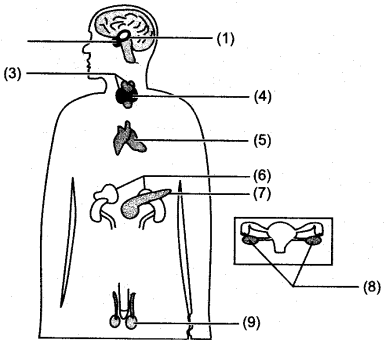
Pancreas Hypothalamus Pituitary Parathyroid Ovaries Adrenal Thyroid Thymus Testes
Answer: (1) Pituitary (2) Parathyroid (3) Hypothalamus (4) Thyroid (5) Thymus (6) Adrenal (7) Pancreas (8) Ovaries (9) Tests.
Question 2: Some of the endocrine glands are shown by the guidelines.
(i) Name the glands 1 to 5.
(ii) Name any two endocrine glands which are not shown in the diagram.
(iii) Name one gland which is both exocrine and endocrine.
Answer: (1) 1. Pituitary, 2. Thyroid1 3. Adrenal, 4. Pancreas, 5. Ovary.
(ii) Thymus, Testis.
(iii) Pancreas.
Question 3: Given below is an outline of the human body showing the important glands.

(i) Name the glands marked 1 to 5.
(ii) Name the hormone secreted by 2. Give one important function of this hormone.
(iii) Name the endocrine oeils present in part 3.
(iv) Name the hormone secreted by part 4. Give one important function of this hormone.
Answer: (i) 1. Pituitary. 2. Thyroid. 3. Pancreas. 4. Adrenal. 5. Ovary.
(ii) Thyroxine.
It regulates the basal metabolism.
(iii) Islets of LangerhAnswer:
(iv) Adrenalin.
It prepares the body for some emergency by causing production of glucose from glycogen in liver, and releasing it into blood.
Question 4: Given alongside are the diagrammatic sketches of some endocrine glands. Observe the figures and answer the following questions :
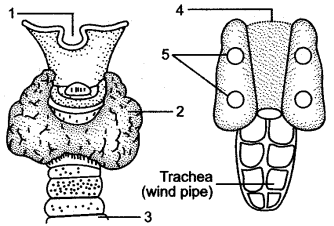
(i) Label the parts numbered 1 to 5.
(ii) Name the hormtmes secreted by (2) and (5).
(iii) Which chemicals in our body are greatly affected by hormones ?
(iv) What is the chemical nature of hormones ?
(v) Name the elements related with the functioning of hormones secreted by the structure (2) and (5).
Answer: (i) 1. Larynx. 2. Left lobe of thyroid gland. 3. Trachea (windpipe). 4. Oesophagus. 5. Parathyroid glands.
(ii) Structure (2) secretes thyroxin hormone and structure (5) secretes parathormone.
(iii) Enzymes; which constitute the enzyme system of the body.
(iv) Hormones may be proteins, amino acids or steroids.
(v) Iodine is related with the functioning of gland (2) calcium, phosphorus are related with the functioning of gland (5).
Question 5: Study the diagram given below and then answer the questions that follow :
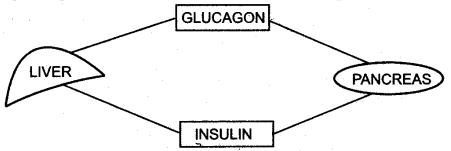
(i) Name the cells of the pancreas that produce (1) glucagon, (2) insulin.
(ii) State the main function of (1) glucagon, (2) insulin.
(iii) Why is the pancreas referred to as an exo-endocrine gland ?
(iv) Why is insulin not given orally but is injected into the body ?
(v) What is the technical term for the cells of the pancreas that produce endocrine hormones ?
(vi) Where in the body is the pancreas located ?
Answer: (i) (1) Alpha cells of islet of Langerhans (2) Beta cells of islet of Langerhans.
(ii) (1) It increases blood sugar level.
(2) It decreases blood sugar level.
(iii) Pancreas produces pancreatic juice which is carried by pancreatic duct into the duodenum. It also produces hormones which are poured into blood. Because of this dual activity, it is called an exo-endocrine gland.
(iv) If insulin is given orally it will be digested by the protein digesting enzymes in the stomach. Hence it has to be injected.
(v) Islets of LangerhAnswer:
(vi) Below the stomach.
Question 6: The sketch below shows a certain condition in an individual:
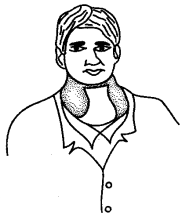
(i) Name the condition.
(ii) What is the underlying cause of this condition ?
(iii) Name two other conditions that could have resulted due to a similar cause.
(iv) Which hormone is required for iodine synthesis ?
(v) Where is thyroid gland located ?
(vi) The hormone secreted by thyroid gland is controlled from which hormone ?
Answer: (i) Goitre
(ii) The thyroid gland enlarges due to deficiency due to deficiency of iodine in the diet.
(iii) 1. Cretinism in children 2. Myxoedema
(iv) Thyroxin
(v) It is located in a mid-ventral position in the posterior part of the pharynx.
(vi) Thyroid stimulating hormone/TSH.
Sketch and Label the Diagram
Question 1: Sketch and label the V. S. of pituitary gland.
Answer:
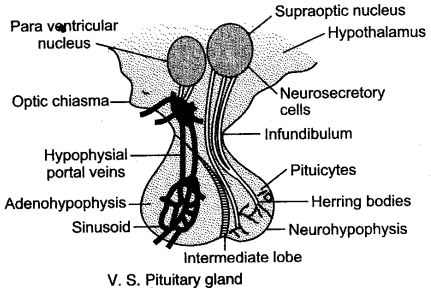
Question 2: Draw and label the structure of thyroid gland.
Answer:
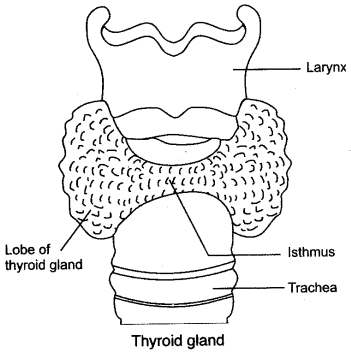
Question 3: Give a labeled diagram of parathyroid gland.
Answer:

Question 4: Sketch and label the structure of adrenal gland.
Answer:

Question 5: Give a labeled diagram of thymus gland.
Answer:
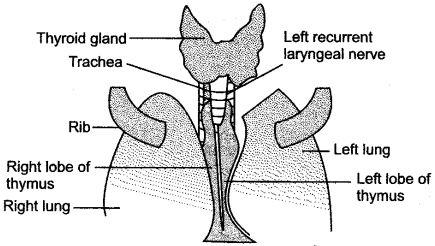
Name the Following
Question:
1. Which gland is exocrine as well as endocrine gland.
2. Which hormone is secreted by the pancreas.
3. Hormone secreted by p-cells of Islets of Langerhans.
4. Disease caused by the deficiency of insulin.
5. The hormone produced by the thyroid gland.
6. Disorder caused by excess of thyroid hormone.
7. Iodine is necessary for the secretion of which hormone.
8. The master gland of the body, because it controls the activity of other endocrine gland also.
9. Hormone controls absorption of water from kidney tubules.
10. Hormone secreted by corpus luteum.
Answer:
1. Pancreas
2. Insulin
3. Insulin
4. Diabetes
5. Thyroxin
6. Exophthalmic goitre
7. Thyroxin
8. Pituitary
9. ADH or Vasopressin
10. Progesterone
Give Technical Terms
Question:
1. What are the substances that control the growth and development in animals?
2. Name the gland in the’body that secretes the so-called ‘Emergency hormone’.
3. When your mouth dries up and the heart begins to beat faster, which hormone brings about the feeling ?
4. Name the hormone which prepares the body to face an emergency situation.
5. Name a condition caused due to hypo secretion of thyroxin in adults.
6. Name the blood vessels which transport hormones from the endocrine glands to the various parts of the body.
7. Name the hormones secreted by the pancreas.
8. The condition which results in the abnormally long bones, long lower jaw bone due to hyper secretion of pituitary hormone.
9. Name the cells of islets of langerhans in pancreas, which secretes insulin and glucagon.
10. Name two hormones secreted by the alimentary canal.
11. Name the hormone which maintains glucose level in the blood.
12. What are releasing hormones?
13. Name a hormone which controls developments of male secondary sexual characters.
14. Name the structure which produces testosterone.
15. The structure which controls the master gland.
16. Name the glands which secrete the following hormones:
(a) Progesterone. (b) Testosterone. (c) ACTH. (d) Relaxin. (e) Adrenaline. (f) Noradrenalin.
17. Name the hormones which lead to the following conditions:
(a) Diabetes mellitus (b) Growth of beard in women (c) Myxedema (d) Gigantism (e) Exophthalmic goitre.
Answer:
1. Hormones
2. Adrenal gland
3. Adrenaline
4. Adrenaline
5. Myxedema
6. Veins
7. Insulin and glucagon
8. Acromegaly
9. 13 cells and a cells respectively
10. Choleocystokinin and secretin
11. Insulin
12. The hormones secreted by the hypothalamus are called releasing hormones, e.g., TSH-RH, FSH-RH and ACTH-RH.
13. Androgens (Testosterone)
14. Testes (Leydig cells)
15. Hypothalamus of the brain
16. (a) Ovary (Corpus luteum) (b) Testes (Leydig cells) (c) Pituitary gland (d) Ovary (e) Adrenal medulla (f) Adrenal medulla
17. (a) Insulin (b) Androgen (Aldosterone) (c) Thyroxine (d) Somatotrophic or Growth Hormone (GH) (e) Thyroxine
Fill in the Blanks
Complete the following sentences with appropriate words :
1. Thomas Addison is called father of endocrinology.
2. Nervous system and Endocrine system are very closely related.
3. The glands with ducts are called Exocrine/ducted glands.
4. A hormone which influences the ossification of bones is Parathormone.
5. The activities of the thyroid gland are controlled by Hormone secreted by the pituitary.
6. A disease caused in children due fo under secretion of thyroxin is Cretinism.
7. In adult deficiency in secretion of thyroid produces a disease called Myxedema.
8. Lack of iodine in diet causes Goitre.
9. The endocrine part of the pancreas is Islet of Langerhans.
10. Tetany is a disease caused by hypoparathyroidism.
11. Insulin makes the liver turn blood sugar into Glycogen.
True & False
Mention, if the following statements are True or False. If false rewrite the wrong statement in its correct form:
1. Hormones are produced by endocrine gland. (True)
2. Hormones are chemically protein. (False, Hormones are always not protein.)
3. The pituitary gland is both exocrine and endocrine in function. (False, The pancreas gland is both exocrine and endocrine in function.)
4. The alpha cells of the pancreas secrete insulin. (False, Hormones act as chemical messengers.)
5. Adrenal gland is called Master gland. (False, pituitary gland is called master gland.)
6. Calcium is the main element of thyroxin. (False, Iodine is the main element of thyroxin.)
7. Adrenal cortex produces emergency hormone adrenaline. (False, Adrenal medulla produces emergency hormone adrenaline.)
8. Adrenal medulla produces adrenaline. (True)
9. Thyroxin regulates metabolism. (True)
10. Rickets is caused due to deficiency of iodine. (False, Goitre is caused due to deficiency of iodine.)
11. Glucagon converts glucose into glycogen. (False, Glucagon converts glycogen into glucose.)
State the Location
| Name | Location |
| Thyroid | It consists of two lobes placed on either side of the trachea on the ventral side in the neck region at the level of the base of the larynx. |
| Adrenal | It consists of a pair of glands situated at the top of each kidney and are enclosed in a connective tissue capsule. |
| Pancreas | The endocrine-part of the pancreas consists of small groups of epithelial cells called the Islets of Langerhans which are found scattered in the pancreas which is situated between the stomach and the duodenum. |
| Prostate gland | At the base of urinary bladder. |
| Pituitary gland | At the base of brain. |
State the Function
Write the functional activity of the following structures:
| Name | Function |
| Thyroxin | It increases rate of metabolism and maintains energy balance in the body. |
| Insulin | In converts glucose into glycogen, decreasing blood sugar level. |
| Testosterone | It is necessary for the development of primary and secondary sexual characters in males. |
| Oestradiol | It is necessary for the development of primary and secondary sexual characters in females. |
| Progesterone | It maintains normal course of pregnancy. |
| Relaxin | It loosens the pelvic ligaments and softens the cervix of uterus during childbirth. |
| Oxytocin | It increases blood pressure, it stimulates uterine contractions during childbirth and causes ejection of milk from mammary glands. |
Choose the Odd One Out
1. Goitre, Cretinism, Scurvy, Myxedema. (Scurvy)
2. Cretinism, Myxedema, Simple goitre, Acromegaly. (Acromegaly)
3. Somatotropin, Gonadotropin releasing hormone, Corticotrophin releasing hormone, Oxytocin. (Oxytocin)
4. Thyroid gland, Adrenal gland, Pituitary gland, Prostate gland. (Prostate gland)
5. Adrenal, liver, thyroid, pituitary. (Liver)
6. Oestrogen, Progesterone, Testosterone, Prolactin. (Prolactin)
7. Oxytocin, Insulin, Prolaction, Progesteron. (Insulin)
8. Growth hormone, TSH, Vasopressin, LH. (Vasopressin)
9. Cushing’s syndrome, Eunuchoidism, Addison’s disease, Virilism. (Eunuchoidism)
10. Aldosterone, Cortisol, Progesterone, Epinephrine. (Progesterone)
11. Testosterone, Epinephrine, Progesterone, Aldosterone. (Epinephrine)
12. Cortisone, Cortisol, Progesterone, Epinephrine. (Progesterone)
13. Insulin, Glucagon, Diabetes insipidus, Diabetes mellitus. (Diabetes insipidus)
14. Glucocorticoids, Mineralocorticoids, Corticotrophin, Sex corticoids. (Corticotrophin)
15. FSH, ICSH, Prolactin, LH. (Prolactin)
16. Insulin, blood sugar, adrenaline, thyroxine. (Blood sugar)
Multiple Choice Questions
1. Which statement is not for a hormone ?
(a) They act on target organs usually away from the source glands.
(b) They are secreted directly into the blood.
(c) They are used again and again like catalysts.
(d) They are produced in very minute quantities and are biologically very active.
2. The basal metabolic rate in body cells is regulated by :
(a) The parathyroid (b) The thyroid
(c) The pituitary (d) The thymus
3. The mammalian thymus is mainly concerned with:
(a) Regulation of body temperature (b) Regulation of body growth
(c) Secretion of thyrotropins (d) Immunological functions
4. Which of the following glands has both endocrine and exocrine functions ?
(a) Pituitary gland (b) Thyroid gland
(c) Pancreas gland (d) Adrenal gland
5. Pancreas is a mixed gland in which:
(a) All cells secrete enzymes and hormones.
(b) Most cells secrete hormones
(c) Few cells secrete enzymes
(d) Enzymes and hormones are secreted by separate cells.
6. Secretin is secreted by :
(a) Testes and stimulates male secondary character
(b) Adrenal glands and stimulates heart beat
(c) Small intestine and stimulates pancreas
(d) Pancreas and stimulates conversion of glycogen into glucose.
7. Vasopressin is concerned with:
(a) Quick digestion (b) Slow heart beat
(c) Concentration of urine (d) Dilution of urine
8. Glucagon is secreted by :
(a) The p cells of islets of langerhans (b) The a cells of islets of langerhans
(c) The p cells of pancreas (d) The Adrenal cortex
9. Leydig cells are meant for:
(a) Formation of sperms (b) To produce progesterone
(c) To produce testosterone (d) Nutrition of sperm
10. Human chronie Gonadotropin:
(a) Stimulates the growth of placenta
(b) Stimulates the development of new follicles
(c) Inhibits the secretion of milk till child birth
(d) Stimulates the corpus luteum to grow and secrete progesterone.
Match the Column
Column ‘II’ is a list of items related to ideas in Column ‘I’. Match the term in Column ‘II’ with the suitable idea given in Column ‘I’.
| Column A | Column B |
| (i) Pituitary | (a) produces male sex characteristics |
| (ii) Ovaries | (b) decreases blood sugar level |
| (iii) Thyroid | (c) increases heart and breathing rate, raises blood pressure |
| (iv) Thymus | (d) produces female sex characteristics |
| (v) Adrenals | (e) is known as emergency hormone |
| (vi) Hypothalamus | (f) regulates the level of calcium and phosphorus |
| (vii) Pancreas | (g) increases rate of metabolism |
| (viii) Testes | (h) maintains the level of calcium |
| (ix) Parathyroid | regulates the amount of water excreted in urine. |
| (x) Cretinism | (j) simulates skeletal growth |
| (xi) Diabetes mellitus | (k) regulates the activities of other glands |
| (xii) Insulin shock | (l) stimulates development of male and female sex organs |
| (xiii) Gigantism | (m) Shortage of glucose in blood. |
| (xiv) Enlargement of breasts in adult males | (n) Over-secretion of growth hormone |
| (xv) Exophthalmic goitre | (o) Excess of glucose in blood |
| (xvi) Acromegaly | (p) Over-secretion of thyroxin |
| (xvii) Addison’s disease | (q) Dwarfism and mental retardation |
| (xviii)Cretinism | (r) Over-secretion of cortical hormones |
| (xix) Dwarfism | (s) Under-secretion of adrenal cortex |
| (xx) Adrenalin | (t) Under-secretion of thyroxin in children |
| (xxi) Vasopressin | (u) Over-secretion of growth hormones in adults |
Answer: (i) (j) (ii) (d) (iii) (g) (iv) (l) (v) (c) (vi) (k) (vii) (b) (viii) (a) (ix) (f) (x) (q) (xi) (o) (xii) (m) (xiii) (n) (xiv) (r) (xv) (p) (xvi) (u) (xvii) (s) (xviii) (t) (xix) (s) (xx) (e) (xxi) (i)
ICSE Solutions for Class 10 Biology
- Cell Division Class 10 ICSE Questions and Answers
- Fundamentals of Genetics Class 10 ICSE Questions and Answers
- Absorption by Roots Class 10 ICSE Questions and Answers
- Transpiration Class 10 ICSE Questions and Answers
- Photosynthesis Class 10 ICSE Questions and Answers
- The Circulatory System Class 10 ICSE Questions and Answers
- The Excretory System Class 10 ICSE Questions and Answers
- The Nervous System and Sense Organs Class 10 ICSE Questions and Answers
- The Endocrine System Class 10 ICSE Questions and Answers
- The Reproductive System Class 10 ICSE Questions and Answers
- Human Population Class 10 ICSE Questions and Answers
- Physical Health and Hygiene Class 10 ICSE Questions and Answers
- Pollution Class 10 ICSE Questions and Answers
